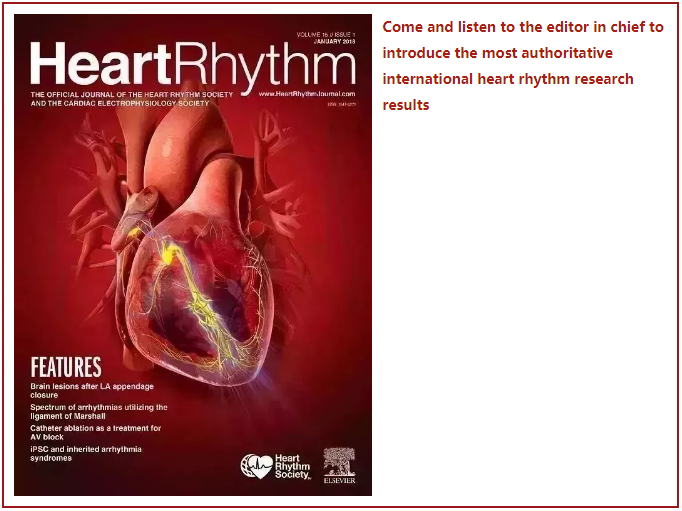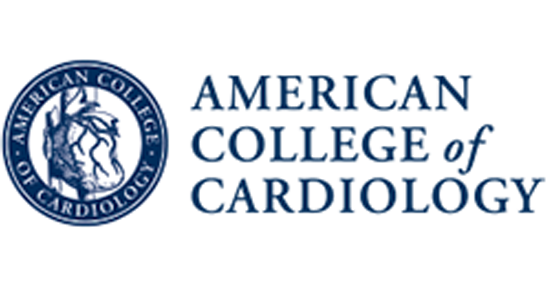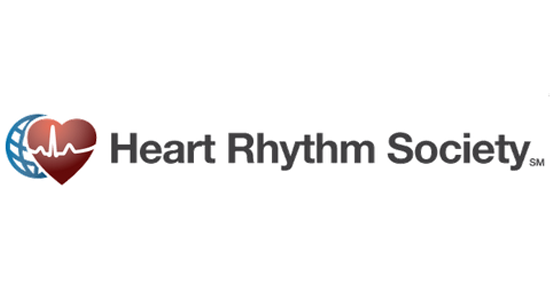HeartRhythm主编—陈鹏生教授语音速递(五月刊 英文版)


Peng-Sheng Chen
The first article is “Dexmedetomidine versus Propofol for Operator-Directed Nurse-Administered Procedural Sedation during Catheter Ablation of Atrial Fibrillation: a Randomized Controlled Study”. The authors randomized 160 consecutive patients undergoing first AF ablation to dexmedetomidine vs propofol. They found that the efficacy of Operator-Directed Nurse-Administered sedation with dexmedetomidine was not different from that with propofol. Hypercapnia occurs less frequently with dexmedetomidine, but patient satisfaction is better with propofol sedation. In selected patients, dexmedetomidine may be used as an alternative to propofol for Operator-Directed Nurse-Administered sedation during AF ablation.
Next up is “Sinus node exit, crista terminalis conduction, interatrial connection, and wavefront collision: Key features of human atrial activation in sinus rhythm”.Fifty consecutive patients undergoing catheter ablation of atrial fibrillation with endocardial atrial voltage >0.5 mV during high-density 3-dimensional mapping were studied. The authors found that sinus node exits varied among patients along a lateral oblique arc extending from the anterior aspect of the superior vena cava (SVC) to the mid-posterior wall of the right atrium (RA). Conduction slowing or block at one of the smooth components that faces the crista terminalis was observed in 54% of cases, including complete block at the SVC musculature and systemic venous sinus in 6% of cases. The authors conclude that during sinus rhythm, atrial activation occurs via distinct sequences mediated by a complex interaction of anatomic factors.
The following article is “Low Voltage Potentials Contribute to Post-Operative Atrial Fibrillation Development in Obese Patients”. The authors studied 106 obese patients with BMI ≥30 kg/m2 and 106 non-obese patients cardiac surgery. All patients underwent epicardial mapping of the right atrium, Bachmann bundle (BB), and left atrium during sinus rhythm. Low-voltage potentials were defined as potentials with peak-to-peak amplitudes below the fifth percentile of all potential amplitudes obtained from nonobese patients. Compared with nonobese patients, obese patients have potentials with lower voltages, especially at Bachmann bundle and left atrium. The percentage of low-voltage potentials was higher in obese than in nonobese patients. BMI and low-voltage potentials were independent predictors for the incidence of early postoperative AF. The authors conclude that obesity may predispose to an overall decrease in atrial voltage and a higher percentage in low-voltage potentials. Bachmann bundle was a predilection area for low voltage within the atria of obese patients.
Up next is “Efficacy of Catheter Ablation From the Non-Coronary Aortic Cusp of Verapamil-Sensitive Atrial Tachycardia Arising Near the Atrioventricular Node”. The efficacy of catheter ablation from the noncoronary aortic cusp (NCC) of verapamil-sensitive atrial tachycardia arising near the atrioventricular node (AVN-AT) has yet to be fully clarified. The authors report that noncoronary aortic cusp catheter ablation terminated AVN-AT in 14 patients but not in 12. The direction of the slow conduction zone was posterior to the earliest atrial activation site in all NCC group patients; however, it was posterolateral and lateral to the earliest atrial activation site in the remaining patients, suggesting that the slow conduction zone existed in the direction of the NCC in the NCC group but was away from the NCC in the non-NCC group. The authors conclude that a close proximity between the NCC and the slow conduction zone of the reentry circuit, but not the local activation time at the NCC, determined the efficacy of NCC catheter ablation in AVN-ATs.
Next up is “Electrophysiological characteristics of septal perforation during left bundle branch pacing”. LBB pacing was attempted in 219 patients and was successful in 212 (96.8% success rate). Septal perforation during lead deployment was identified in 30 patients (14.1%).Peak troponin release was 188 pg/mL. Mean unipolar impedance of <450 Ω for diagnosing septal perforation had high sensitivity (100%) and specificity (96.6%). Current of injury amplitude reduced from 15.4 mV just before perforation to 0.9 mV after perforation. Based on morphology, unfiltered unipolar electrograms were classified into 2 patterns: type I (QS pattern) seen in 20 patients (67%) due to complete perforation and type II (RS pattern) seen in 10 patients (33%) due to partial perforation, with 80% showing capture. All 30 patients underwent successful reimplantation at a new site. No patient developed lead dislodgment during mean follow-up of 9.9 months. Although considered one of the concerns of LBB pacing, septal perforation, when recognized promptly during implantation by unipolar parameters and treated by reimplantation, would be benign and not associated with an unfavorable outcome.
Up next is “Response of functional mitral regurgitation in nonischemic cardiomyopathy to left bundle branch pacing”. A total of 73 patients were divided into 2 groups based on the severity of functional mitral regurgitation into group I with mild and group II with significant functional mitral regurgitation. LBB pacing resulted in significant reduction in QRS duration in both groups. Percentage change and absolute change in LV ejection fraction were similar in both groups. In group II, 31 patients (82%) showed significant reduction in functional mitral regurgitation severity during follow-up. The authors conclude that LBB pacing resulted in excellent electrical resynchronization with significant reduction in functional mitral regurgitation severity in the majority of patients. There was no worsening of functional mitral regurgitation from baseline in any patient.
Coming up is “Leadless AV synchronous pacing in an outpatient setting: early lessons learned on factors affecting AV synchrony”. Twenty patients who received a leadless Medtronic Micra VDD pacemaker (Micra™ AV, Medtronic) had a total of 816 hours of Holter ECG recorded and analyzed. During predominantly paced episodes (≥80% ventricular pacing), median AV synchrony was 91% when patients had sinus rates 50-80/min. Successful VDD pacing in the outpatient setting during higher sinus rates is more difficult to achieve than can be presumed based on initial feasibility studies. The devices often require multiple reprogramming to maximize AV sequential pacing.
The next paper is “Subcutaneous Versus Transvenous Implantable Defibrillator in Patients with Hypertrophic Cardiomyopathy”. The authors included 2047 patients with TV-ICD and 626 patients with S-ICD, followed for an average of 1650 days and 933 days, respectively. Patients with HCM and TV-ICD had a significantly higher rate of device therapy compared to those with S-ICD, driven by a high incidence of ATP therapy in the TV-ICD group, which accounted for >67% of therapies delivered. Shock incidence was similar between groups, both in the general and the matched cohorts. The authors conclude that patients with HCM and S-ICD had a significantly lower therapy rate than patients with TV-ICD without difference in shock therapy, suggesting potentially unnecessary ATP therapy. Empirical ATP programming in patients with HCM may be unbeneficial.
The following article is titled “Impact of Timing of Transvenous Lead Removal on Outcomes in Infected Cardiac Implantable Electronic Devices”. Using the nationally representative, all payer, Nationwide Readmissions Database, the authors evaluated 12,999 patients who underwent Transvenous Lead Removal for CIED infection. Among them, 8834 (68%) underwent early Transvenous Lead Removal and 4165 (32%) underwent delayed Transvenous Lead Removal. Delayed Transvenous Lead Removal was associated with a significant increase in in-hospital mortality and higher adjusted odds of major adverse events and postprocedural length of stay than early transvenous lead removal. The authors conclude that delayed transvenous lead removal in patients with CIED infection is associated with increased in-hospital mortality and major adverse events, especially in patients with systemic infection.
The next article is “Preclinical Safety and Electrical Performance of Novel Atrial Leadless Pacemaker with Dual-Helix Fixation”. The authors report a new Leadless Pacemaker with a dual-helix fixation mechanism specific to the RA anatomy. Leadless Pacemakers were successfully implanted in 10 ovine subjects with no complications. The pacing capture threshold improved significantly over time from implant to week 12. Sensing amplitudes and pacing impedances were stable from implant to week 12. Gross pathology and microscopic histology revealed no adverse interactions and no evidence of device dislodgment or clinically significant myocardial perforation. The authors conclude that the novel atrial Leadless Pacemaker demonstrated successful implantation, with acceptable electrical performance, mechanical stability, and safety in a 12-week preclinical study.
The next article is “Importance of Newer Cardiac Magnetic Resonance-Based Risk Markers for Sudden Death Prevention in Hypertrophic Cardiomyopathy: An International Multicenter Study”. The authors performed a longitudinal study of 1149 consecutive HCM patients. European Society of Cardiology (ESC) risk score was retrospectively analyzed with respect to the known clinical outcome. Of these patients, 162 (14%) experienced ICD therapy terminating VT/VF 4.6 years after implant. CMR-based markers solely or in combination led to ICD implantation in 49 of the 162 patients (30%) experiencing device therapy. Particularly low ESC scores (<4%/5 years) would have excluded an ESC ICD recommendation for 67 patients who nevertheless experienced appropriate ICD therapy, including 26 with the CMR-based risk markers not part of the ESC formula. The authors conclude that identification and incorporation of novel guideline-supported CMR-based risk markers enhance selection of HCM patients for sudden death prevention with ICDs. Absence of CMR-based markers from the ESC risk score accounts, in part, for it not identifying many HCM patients with sudden death events. These data support inclusion of CMR as a routine part of HCM patient evaluation and risk stratification.
Coming up is “Implantable defibrillator-detected heart failure status predicts atrial fibrillation occurrence”. The authors evaluated the association between the values of the multisensor HF HeartLogic index and the incidence of AF, and assessed the performance of the index in detecting follow-up periods of significantly increased AF risk. The HeartLogic feature was activated in 568 ICD patients. Median follow-up was 25 months. The HeartLogic index crossed the threshold value 1200 times. The weekly time of IN-alert state was independently associated with AF burden, after correction for baseline confounders. Comparison of the episode rates in the IN-alert state with those in the OUT-of-alert state yielded hazard ratio ranging from 1.57 to 3.11 for AF burden from ≥5 minutes to ≥23 hours. The authors conclude that the HeartLogic alert state was independently associated with AF occurrence. The intervals of time defined by the algorithm as periods of increased risk of HF allow risk stratification of AF according to various thresholds of daily burden.
Up next is “The role of CACNA1C in Brugada syndrome prevalence and phenotype of probands referred for genetic testing”. A total of 709 patients were included in this study. 563 consecutively referred BrS probands underwent CACNA1C sequencing. In the discovery cohort, the authors identified 11 different rare variants in 9 patients; 10 of the variants (5%) were considered potentially causative based on their frequency in the general population. Functional studies revealed a loss of function for 9 variants, pointing to a prevalence of CACNA1C causative variants in 4% of the discovery cohort. Genotype-phenotype correlation showed that pathogenic variants are significantly more frequent in patients with shorter QTc (12.9% vs 2.2% in patients with QTc <390 ms). The authors conclude that CACNA1C is an infrequent but definitive cause of BrS typically associated with short QT. Functional studies are highly relevant to improve variant interpretation.
Next up is “Temporal and Geographic Trends in Women Operators of Electrophysiology Procedures in the United States”. The authors extracted data from the Medicare Provider Utilization and Payment Database (MPUPD) from 2013-2019. The proportion of women operators was compared across the seven-year period. On average annually 5% (n=187) of the 3,524 EP operators were women. Procedure-specific analyses demonstrated similarly low proportion of women EP operators across each procedure type. Despite a 137% increase in the total number of AF ablationists over the 7-year period, the proportion of women remained unchanged (P=NS). The number of SVT/AFL ablationists and device operators remained constant over time as did the proportion of women operators (P=NS). The authors conclude that women EP operators remain under-represented, and the proportion of women is stagnant even in areas of major clinical growth such as AF ablation. One fifth of states had no women operators who performed >10 of any given EP procedure annually.
The next article is “Frailty in patients undergoing percutaneous left atrial appendage closure”. The authors identified 21,787 patients 65 years and older in Medicare fee-for-service claims who underwent LA appendage closure, or LACC, between 2016 and 2019. 10,740 (49%) were considered frail, including 3441 (15.8%) in the high-risk group. After adjusting for age, sex, and comorbidities, Hospital Frailty Risk Score >15 was associated with a higher risk of long hospital stay, 30-day readmission, 30-day and 1-year mortality. The authors conclude that frailty is common in patients undergoing LA appendage closure and is associated with increased risks of long hospital stay, readmissions, and short-term mortality.
Up next is “A Patient-Specific Re-Engineered Cardiomyocyte Model Confirms the Circumstance-Dependent Arrhythmia Risk Associated with the African-Specific Common SCN5A Polymorphism”. The p.S1103Y-SCN5A common variant, which is present in ∼8% of individuals of African descent, may be a circumstance-dependent, sudden cardiac death-predisposing, proarrhythmic polymorphism in the setting of hypoxia-induced acidosis or QT-prolonging drug use. iPSC-cardiomyocytes were generated from a 14-year-old African American male with that variant. Under baseline conditions, there was no difference in APD90 values between variant and control myocytes. In the setting of acidosis (pH 6.9), there was a significant increase in APD90 in variant iPSC- cardiomyocytes compared to control. The authors conclude that although the African-specific p.S1103Y-SCN5A common variant had no effect on APD90 under baseline conditions, the physiological stress significantly prolonged APD90 in patient-specific, re-engineered heart cells.
The next paper is “Non-contact whole-chamber charge density mapping of the left ventricle: preclinical evaluation in a sheep model”. The purpose of this study was to evaluate the feasibility and accuracy of noncontact whole-chamber left ventricular (LV) charge density mapping. Electrograms recorded at sites of tissue contact were compared to the nearest noncontact charge density-derived electrograms to calculate signal morphology cross-correlations and time differences. Results showed that areas under receiver operating characteristic curves (AUCs) of charge density -defined dense and total LV scar were 0.92. Morphology cross-correlation between 8677 contact and corresponding noncontact electrograms was 0.93, with a mean time difference of 2.5 ms. The authors conclude that noncontact LV charge density mapping can accurately delineate ischemic scar. Charge density-derived ventricular electrograms correlate strongly with conventional contact-based electrograms. Regions with consistently slow conduction are often at scar borders and tend to harbor localized irregular activation during VF.
Up next is “Long-term Performance of Novel Communicating Antitachycardia-Enabled Leadless Pacemaker and Subcutaneous Implantable Cardioverter-Defibrillator System: a Comprehensive Preclinical Study”. The authors implanted leadless pacemaker in 68 canine subjects, and in 38 an S-ICD was implanted as well. The animals were serially evaluated for 18 months. Modular cardiac rhythm management communication was successful in 1022 of 1024 evaluations (99.8%). The mean communication threshold was stable afterward for 18 months. The mean pacing capture threshold remained stable and impedance and R-wave amplitudes were within acceptable ranges throughout. The authors conclude that this is the first modular cardiac rhythm management system demonstrated excellent performance up to 18 months in a preclinical model.
The next paper is “Regional Heterogeneity in Determinants of Atrial Matrix Remodeling and Association with Atrial Fibrillation Vulnerability Post-Myocardial Infarction”. Myocardial infarction was induced in pigs. At approximately 14 days post-MI, an atrial electrical stimulation protocol was performed, after which a matrix metalloproteinases radiotracer was infused. The results show that AF could be induced in 89% (8/9) of the post-MI pigs but none of the controls. matrix metalloproteinases activity increased by approximately 2-fold in most atrial regions post-MI, whereas fibrillar collagen content was unchanged or actually reduced in right atrial regions and increased in left atrial regions. The authors conclude that AF vulnerability early post-MI was associated with a heterogeneous pattern of atrial extracellular matrix remodeling, detectable by noninvasive molecular imaging. Detection of early atrial matrix metalloproteinases activation post-MI may help define the myocardial substrate underlying AF.
These original research articles are followed by 3 research letters. The first one is“Post-FDA approval "real-world" safety profile of different steerable sheaths during catheter ablation: A Food and Drug Administration MAUDE database study”. The second one is“Effect of Malnutrition on Outcomes of Patients Hospitalized for Implantable Cardioverter-Defibrillator Placement”. The third one is “Unequal prescription of anticoagulants among females and males with atrial fibrillation and similar stroke risk: should we omit sex category from the CHA2DS2-VASc score?”.These letters are followed by a Creative Concept paper called “Bedwetting from the heart”, which talks about nocturnal enuresis and sudden death.
I hope you enjoyed this podcast. For Heart Rhythm, I’m the Editor-In-Chief, Dr. Peng-Sheng Chen.











